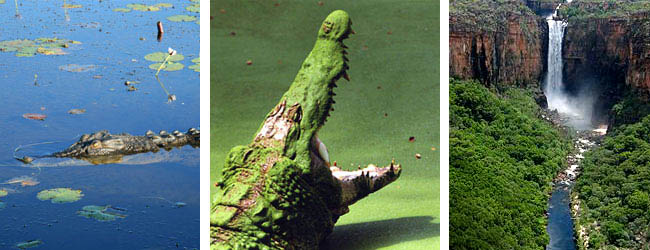Campervan in Kakadu - Outback Guide
Kakadu National Park is a place of exceptional beauty and unique diversity. Spanning almost 20,000 square kilometres of practically untouched land, Kakadu is World Heritage Listed because of its unsurpassed natural and cultural value.
This is a land where mangrove-fringed coastal areas brilliantly contrast with endless flood plains, lowland hills, sandstone escarpments and untouched woodland and forest habitats. This variety in landscape makes Kakadu one of the most biologically diverse areas in the country and an absolute must while visiting the Northern Territory.

Travel Distances
Kakadu National Park has two entrances; one in the north and one in the south. The northern entrance can be reached from Darwin via the Arnhem Highway. Travellers should allow 2, to 2 and a half hours to complete the 150 kilometre journey.
The southern entrance can be reached via the Stuart Highway, with the entry point located at Pine Creek. This entrance is approximately 230 kilometres south of Darwin, 1300 kilometres from Alice Springs and 90 kilometres north of Katherine.
Airports and Campervan Depots
There are two main airports tourists use to fly into the Northern Territory. Alice Springs Airport and Darwin International Airport are both located near campervan depots and are ideal places to begin your campervan holiday in Kakadu.
Campervan travellers can choose to either pick up their vehicle from Alice Springs or Darwin. A one-way rental is a popular option for those wishing to simply travel between the two and not backtrack on where they have already driven.
Park Use Fees
A fee of $25 is required for all people over 16 who enter the park. This entry fee is valid for 14 days and is payable online and at selected outlets, including Tourism Top End, the Bowali Visitor Centre, Aurora and the Katherine Visitor Information Centre.
What to See and Do
Kakadu National Park is divided into 7 regions:
South Alligator Region
The Mamukala wetlands are a popular attraction within this region of the park, with an observation platform allowing you to view the dramatic diversity of birdlife that frequent this area. The 3 kilometre walk adjacent to the wetlands is another great way to get a taste of the seasonal changes that occur here, and takes between 1 and 2 hours to complete.
The Gu-ngaree walk is another fantastic trek that will take you through monsoon forest, woodlands and along the beautiful Anggardabal Billabong. Hikers should allow 2 hours for this walk.
Jabiru Region
Jabiru is the main township of Kakadu and is regarded as the gateway to the park and Arnhem Land. It is a fantastic place to begin your adventure in Kakadu, with the Bowali Visitor Centre providing a wealth of information about the park in the form of videos and displays.
East Alligator Region
The East Alligator Region is home to extensive stone country, magnificent rock art, endless floodplains and the waters of the stunning East Alligator River. Take the Guluyambi boat cruise up the river and discover the beauty of this dramatic section of the park.
Nourlangie Region
The Nourlangie region of Kakadu offers some of the most incredible walks available in the park. Walks you simply cannot miss include the Anbangbang Billabong, Nawurlandja Lookout walk, Nanguluwur art site walk and the Gubara Pools walk. Each of these walks offers something amazing and unique and should not be passed up.
Yellow Water Region
The wetlands of the Yellow Water Region are world famous and simply cannot be missed. A boardwalk provides unsurpassed views of this unique landscape, while a water boat cruise provides a fantastic opportunity to view the unique wildlife of the wetlands.
Jim Jim and Twin Falls Gorge Region
This region can only be accessed during the dry season and is only suitable for 4WD vehicles. The Jim Jim Falls plunge pool is spectacularly surrounded by 150 metre high cliffs and is a stunning sight.
The Twin Falls Gorge is equally as awe-inspiring, with walking and boat tours popular ways to explore this magnificent example of nature.
Mary River Region
The Mary River Region offers spectacular bushwalks, mind-blowing waterfalls and glorious waterholes. Gunlom lookout offers superb views over Southern Kakadu, while the Yurmikmik walks also provide picturesque views over this dazzling region.
Climate and Weather
Kakadu National Park experiences 6 distinctive seasons throughout the year. However, be sure to check weather conditions before travel as conditions can change at any time.
- Kakadu's monsoon season falls between December and March, with the climate relatively hot and humid throughout the day and night.
- During April, clear skies prevail and the streams run clear. Many of the park's plants are also fruiting.
- May to June generally brings about cool weather, and the wetlands become carpeted with spectacular water lilies.
- From June to August the dry season takes hold of the park and most streams stop flowing and the floodplains quickly dry up.
- The heat takes its toll on the months of August, September and October, with dry weather bringing out the snakes and wood swallows.
- October to December marks the pre-monsoon season and is when the streams begin to run and new growth becomes widespread.
Best Time to Visit
Any time of the year can be a good time to visit Kakadu National Park; however each season has its advantages and disadvantages.
The dry season (May to September) is generally regarded as the best time to visit, as most of the roads are open and the weather remains reasonably reliable.
Another great time to visit is during the cool season (June to August). However, as this falls within the school holidays, you should expect the park to be packed full of tourists.
What to Wear?
During the day it can get incredibly hot in Kakadu National Park, therefore it is best to dress in loose clothing that will still protect you from the sun and insect bites. Sunscreen, wide brimmed hats and sunglasses are necessities, while repellant is also essential to have on hand.
Wildlife
Kakadu is home to an impressive 68 species of mammals, more than 120 reptiles, 26 frogs, over 300 tidal and freshwater fish species, more than 10,000 species of insects and an immense collection of 290 bird species.
Kakadu is also home to Australia's two species of crocodiles; freshwater and estuarine (saltwater). Freshwater crocodiles are usually shy animals but can be aggressive if disturbed, so do not approach them. Saltwater crocodiles can be found in the freshwater floodplains, billabongs, rivers and coastal waters. These crocodiles are typically very aggressive and have been known to attack and kill people in Kakadu, so it is important to obey all warning signs.
Driving Restrictions and Tips
Many of the roads at the top end of Kakadu National Park can be hazardous so it is essential to travel slowly along them. Many of the roads also only permit 4WD access and campervans are not permitted on unsealed roads at any time.
The two main roads through Kakadu, the Arnhem and the Kakadu Highways, are sealed, however many of the roads that lead to the park's major attractions are unsealed. This is when an organised tour becomes useful.
During the wet season, the roads can get very slippery, while in the dry season, the dust from other vehicles can obscure your vision. It is important to drive with care at all times.
It is also important to keep an eye out for wildlife, and occasionally beep your horn to alert them of your presence.
Nearby Attractions
Kakadu National Park is ideally situated in Australia's Top End within a day or two's driving distance to the Northern Territory's best attractions.
Darwin is situated just a few hour's drive away and is a city that boasts a rich culture and beautiful landscapes. Litchfield National Park is positioned nearby and is another of Australia's natural treasures. Litchfield boasts stunning tropical waterfalls and swimming holes and is a truly stunning destination.
Humpty Doo is another popular nearby stopping spot. Humpty Doo boasts a strong history and the local reptile park is ideal for those wishing to get up close to the crawly critters of the Top End.
What to bring?
It is absolutely necessary to bring plenty of water to Kakadu National Park, regardless of the length of your stay. Ensuring you always have fuel in your petrol tank is also important as distances between roadhouses can be vast.
Appropriate clothing, sun protection, insect repellant and shoes are also vital, because of the changing weather conditions. This is the outback, so remember it gets extremely hot!
It is also a good idea to bring a suitable amount of food. The shops within the park are quite expensive, so it works out a lot cheaper to bring your own in.
Another must-have for your campervan adventure in Kakadu is your camera. The landscapes here are unlike anywhere else in the world so you will want to remember your memories of this place.
Places to Stay
There a many camping areas available in and around Kakadu National Park, with some run by the park and others commercially operated. All camping within the park operates on a "first in, first served" basis, but it is a good idea to ring the Bowali Visitor Centre beforehand.
Camping fees range up to $10 per person, per night, with some of the basic campgrounds not charging at all. Campgrounds that charge $10 per night include Merl, Muirella, Madugal 1 & 2, Garnamarr and Gunlom. All of these sites permit alcohol consumption so keep this in mind if you are travelling with children.
When camping in Kakadu National Park please remember to be considerate of other park users, only light fires in the fireplaces provided, only collect wood from the woodbins, set up camp at least 50 metres away from water bodies and do not feed the wildlife.
Shops/Supermarkets
Jabiru is the main service centre of Kakadu and offers a service station, supermarket, newsagent, post office, medical centre and chemist.
The Aurora Kakadu Resort Store, which is located in the South Alligator Region, sells petrol, LPG gas, diesel, food and souvenirs.
Roadhouses and Petrol Stations
While travelling within Kakadu National Park it is important to refuel your vehicle as frequently as possible. Conditions here can change rapidly and distances between petrol stations and roadhouses can be quite large.
Petrol in the outback also tends to be more expensive in the outback. For the latest information on Australian fuel prices visit Motormouth.
Unleaded and leaded petrol, and diesel fuel can be found at the following locations:
- Kakadu Resort
- Jabiru
- Cooinda
- Wirnwienmila Mary River Road House
For a more comprehensive list of roadhouses in Australia, visit our Outback Roadhouse Guide.
'If you respect the land, then you will feel the land. Your experience will be one that you cannot get anywhere else in the world' - Brian Baruwei, Wurrkbarbar clan.

